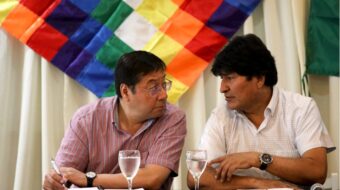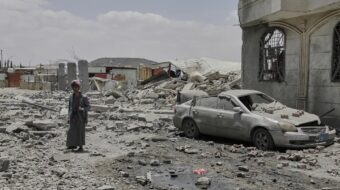On Oct. 2 Mexicans observed the 40th anniversary of the 1968 Tlatelolco massacre with a march of tens of thousands of people through Mexico City and other events. Veterans of 1968 marched alongside students who were not even born then, joining with farmers and striking teachers. In Mexico City, the local government put flags at half mast.
The Tlatelolco massacre took place 10 days before the 1968 Summer Olympic Games in Mexico City. Student activists had sought to use the international attention the games brought to the Mexican capital to push for democratic freedoms and release of political prisoners. All summer, there had been marches and protests by university and high school students. In September, the authoritarian president, Gustavo Diaz Ordaz of the Revolutionary Institutional Party (PRI) ordered the army to take over the National Autonomous University of Mexico, provoking bigger marches.
On Oct. 2, 1968, at least 15,000 marched, and in the evening 5,000 students, workers and neighborhood residents congregated at the Plaza of the Three Cultures in the outlying Tlatelolco neighborhood. Without warning, police and soldiers opened fire on the unarmed crowd and kept blazing away as people desperately tried to seek shelter. Though no official count of the deaths was ever released, and the government put out false information about the demonstrators having “shot first,” Mexican journalist Elena Poniatowska published a searing book (“La Noche de Tlatelolco,” 1971) based on interviews with witnesses and survivors. Poniatowska’s book clearly demonstrated that the government had opened fire without provocation and that possibly more than 300 people had been killed.
There was U.S. government involvement. The notorious director of the FBI at the time, J. Edgar Hoover, as well as the CIA, saw the growth of left-wing dissent in Mexico as a major threat. The Mexican government was fine with this view. While Mexico took a publicly independent stance in the Cold War, some Mexican high officials, including presidents Lopez Mateos and Echeverria, were subsequently revealed by former CIA agent Philip Agee to have been CIA “assets.” The student movement was infiltrated by agents and provocateurs, some of whom took on a disruptive ultra-leftist guise, while others red-baited student leaders.
Left-wing dissent in Mexico, though not part of some “Soviet plot” as both the U.S. and Mexican government alleged, was very real. After the Cuban Revolution, many public figures in Mexico, including revered former President Lazaro Cardenas, expressed strong support for Fidel Castro’s new government and denounced efforts by the United States to topple it. And Mexico had its own rich revolutionary tradition. The Communist Party of Mexico had counted in its ranks some of the most respected figures in the workers movement and in the arts.
In 1959-60, the government had harshly suppressed powerful strikes by railway workers and teachers, jailing a number of left-wing labor leaders. In 1962, the army and police had massacred a noted peasant leader, Ruben Jaramillo, who was both a Methodist minister and a Communist Party member, and his entire family. In 1968, some key leftist labor leaders were still in prison, including railway worker leaders Valentin Campa and Demetrio Vallejo, both Communists. The student demands included the release of all such political prisoners.
The massacre of students and workers in the Plaza of the Three Cultures was not the only repressive act that took place under president Diaz Ordaz and his interior minister and successor, Luis Echeverria Alvarez. There were more killings of farmers, students and workers, often in the form of “disappearances”. But the blatant public nature of the Tlatelolco slaughter stuck in people’s minds both in Mexico and abroad.
Especially since the PRI lost the presidency in 2000, there have been constant demands for the opening of police and army files about the incident, with very limited success. Another demand has been for the prosecution of surviving leaders of the government at the time. These also have not met with success. Recently there have been discoveries of what might be mass graves of people “disappeared” by the authorities of that period.
Last week, the leadership of the PRI, supported by the currently ruling right-wing National Action Party, PAN, made an admission that yes, some bad things had happened in 1968, but suggested that bygones should be bygones. On the other hand, the parliamentary left, consisting of the PRD (Revolutionary Democratic Party) and allies, has demanded that the government recognize that the events of 1968 constitute an unpunished crime of the state.









